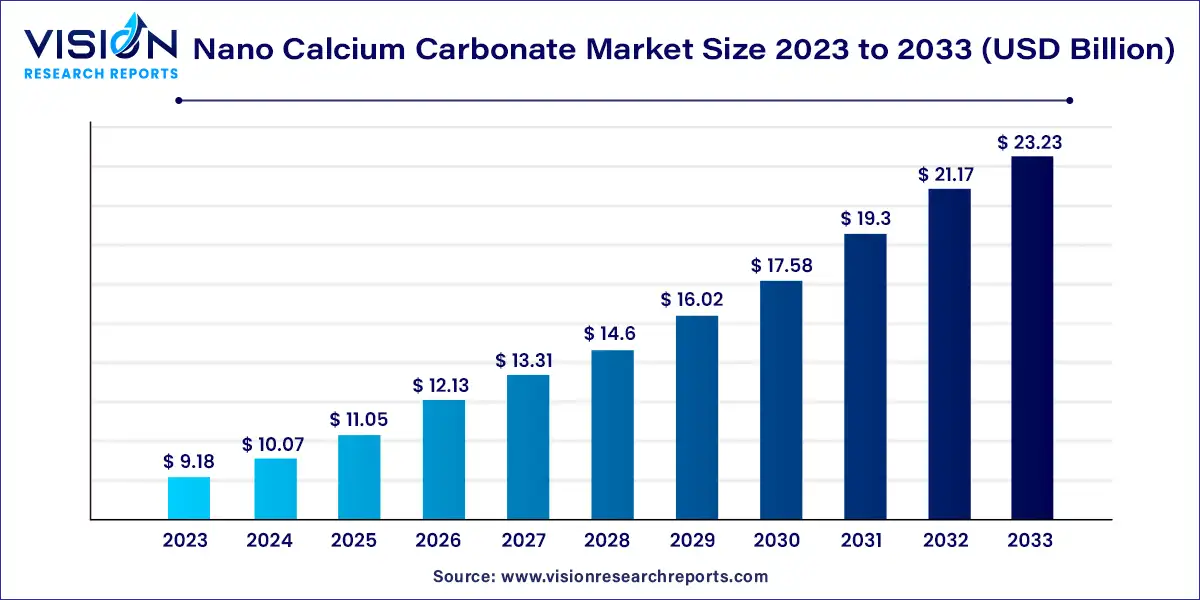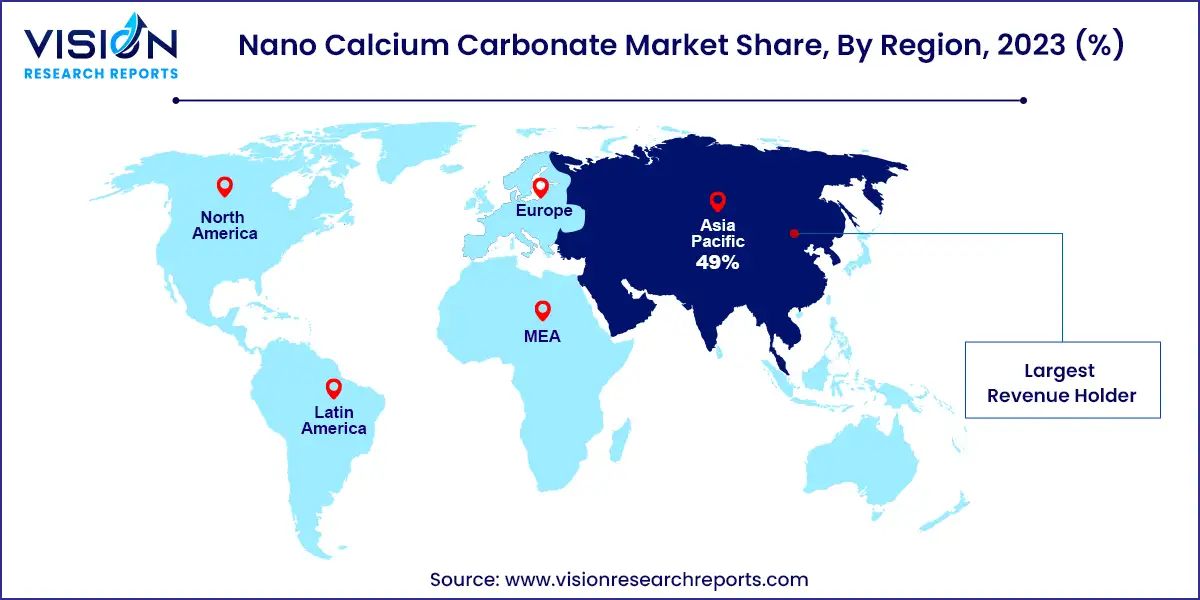The global nano calcium carbonate market size was estimated at around USD 9.18 billion in 2023 and it is projected to hit around USD 23.23 billion by 2033, growing at a CAGR of 9.73% from 2024 to 2033. Nano calcium carbonate is a finely ground form of calcium carbonate, with particle sizes typically in the nanometer range. This material is widely used across various industries due to its exceptional properties, such as high surface area, improved dispersion, and enhanced mechanical strength. It is primarily employed as a functional additive in sectors like plastics, rubber, paints, coatings, adhesives, and sealants. The increasing demand for lightweight and durable materials in these industries is driving the growth of the nano calcium carbonate market.

The growth of the nano calcium carbonate market is primarily driven by its increasing application across various industries, particularly in plastics, rubber, and paints and coatings. The material’s ability to enhance product strength, durability, and performance makes it highly sought after, especially in sectors focused on developing lightweight and efficient materials. Additionally, the rising demand for high-quality coatings in the construction industry and the expansion of the automotive sector further fuel market growth. Technological advancements in manufacturing processes have also played a crucial role in reducing production costs and improving product quality, thereby making nano calcium carbonate more accessible and appealing to a broader range of industries.
The Asia Pacific region dominated the market in 2023, accounting for over 49% of the total revenue. This is largely due to the region's substantial and growing demand for plastic and rubber products, driving the need for nano calcium carbonate as a filler material in these industries. Additionally, economic growth across Asia Pacific is contributing to increased consumption of goods that incorporate nano calcium carbonate.
| Attribute | Asia Pacific |
| Market Value | USD 4.49 Billion |
| Growth Rate | 9.75% CAGR |
| Projected Value | USD 11.38 Billion |
In North America, the market is projected to grow at a CAGR of 9.53% by 2033. The region's well-established manufacturing sector significantly contributes to the demand for nano calcium carbonate in the production of various goods. Technological advancements may also lead to new applications for nano calcium carbonate, further boosting its demand. Additionally, the post-COVID-19 surge in demand for fortified foods in North America is driving the use of nano calcium carbonate as a food additive to enhance nutritional content, thereby contributing to the growth of the regional market.

In 2023, the plastics application segment led the industry, capturing 37% of the total revenue. This dominance is due to the increasing use of nano calcium carbonate in the plastics sector as a cost-effective and stable alternative to plastic resins, while also enhancing the physical properties of the final products. Nano calcium carbonate is a highly refined, high-purity form of calcium carbonate with a small particle size and large surface area, making it an ideal choice for improving the performance of plastics. It contributes to increased strength, stiffness, and dimensional stability of plastic products.
Additionally, nano calcium carbonate is widely used as a filler in the rubber industry, where it enhances the physical properties of rubber products and reduces production costs by substituting more expensive rubber polymers. It also improves the processing characteristics of rubber, such as flowability and moldability, and is typically used in concentrations of 1-10% by weight, depending on the application. The growth of end-use industries is anticipated to further drive market expansion in the coming years. Advances in processing technologies have enabled the production of high-quality nano calcium carbonate with consistent particle size and purity, leading to increased adoption across various industries. Moreover, rising construction and infrastructure development in developing nations are fueling the demand for building materials, thereby boosting the industry's growth.
By Application
By Region
 Cross-segment Market Size and Analysis for
Mentioned Segments
Cross-segment Market Size and Analysis for
Mentioned Segments
 Additional Company Profiles (Upto 5 With No Cost)
Additional Company Profiles (Upto 5 With No Cost)
 Additional Countries (Apart From Mentioned Countries)
Additional Countries (Apart From Mentioned Countries)
 Country/Region-specific Report
Country/Region-specific Report
 Go To Market Strategy
Go To Market Strategy
 Region Specific Market Dynamics
Region Specific Market Dynamics Region Level Market Share
Region Level Market Share Import Export Analysis
Import Export Analysis Production Analysis
Production Analysis Others
Others